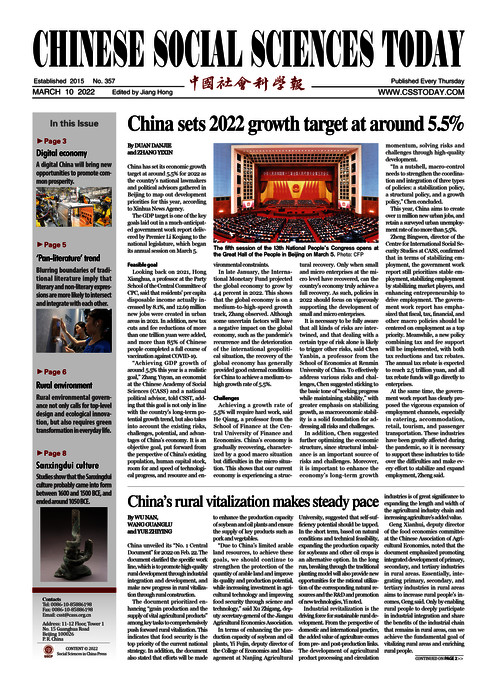China sets 2022 growth target at around 5.5%
2022-03-10 14:30:22
The fifth session of the 13th National People’s Congress opens at the Great Hall of the People in Beijing on March 5. Photo: CFP
By DUAN DANJIE
and ZHANG YIXIN
China has set its economic growth target at around 5.5% for 2022 as the country’s national lawmakers and political advisors gathered in Beijing to map out development priorities for this year, according to Xinhua News Agency.
The GDP target is one of the key goals laid out in a much-anticipated government work report delivered by Premier Li Keqiang to the national legislature, which began its annual session on March 5.
Feasible goal
Looking back on 2021, Hong Xianghua, a professor at the Party School of the Central Committee of CPC, said that residents’ per capita disposable income actually increased by 8.1%, and 12.69 million new jobs were created in urban areas in 2021. In addition, new tax cuts and fee reductions of more than one trillion yuan were added, and more than 85% of Chinese people completed a full course of vaccination against COVID-19.
“Achieving GDP growth of around 5.5% this year is a realistic goal,” Zhang Yuyan, an economist at the Chinese Academy of Social Sciences (CASS) and a national political advisor, told CSST, adding that this goal is not only in line with the country’s long-term potential growth trend, but also takes into account the existing risks, challenges, potential, and advantages of China’s economy. It is an objective goal, put forward from the perspective of China’s existing population, human capital stock, room for and speed of technological progress, and resource and environmental constraints.
In late January, the International Monetary Fund projected the global economy to grow by 4.4 percent in 2022. This shows that the global economy is on a medium-to-high-speed growth track, Zhang observed. Although some uncertain factors will have a negative impact on the global economy, such as the pandemic’s recurrence and the deterioration of the international geopolitical situation, the recovery of the global economy has generally provided good external conditions for China to achieve a medium-to-high growth rate of 5.5%.
Challenges
Achieving a growth rate of 5.5% will require hard work, said He Qiang, a professor from the School of Finance at the Central University of Finance and Economics. China’s economy is gradually recovering, characterized by a good macro situation but difficulties in the micro situation. This shows that our current economy is experiencing a structural recovery. Only when small and micro enterprises at the micro level have recovered, can the country’s economy truly achieve a full recovery. As such, policies in 2022 should focus on vigorously supporting the development of small and micro enterprises.
It is necessary to be fully aware that all kinds of risks are intertwined, and that dealing with a certain type of risk alone is likely to trigger other risks, said Chen Yanbin, a professor from the School of Economics at Renmin University of China. To effectively address various risks and challenges, Chen suggested sticking to the basic tone of “seeking progress while maintaining stability,” with greater emphasis on stabilizing growth, as macroeconomic stability is a solid foundation for addressing all risks and challenges.
In addition, Chen suggested further optimizing the economic structure, since structural imbalance is an important source of risks and challenges. Moreover, it is important to enhance the economy’s long-term growth momentum, solving risks and challenges through high-quality development.
“In a nutshell, macro-control needs to strengthen the coordination and integration of three types of policies: a stabilization policy, a structural policy, and a growth policy,” Chen concluded.
This year, China aims to create over 11 million new urban jobs, and retain a surveyed urban unemployment rate of no more than 5.5%.
Zheng Bingwen, director of the Centre for International Social Security Studies at CASS, confirmed that in terms of stabilizing employment, the government work report still prioritizes stable employment, stabilizing employment by stabilizing market players, and enhancing entrepreneurship to drive employment. The government work report has emphasized that fiscal, tax, financial, and other macro policies should be centered on employment as a top priority. Meanwhile, a new policy combining tax and fee support will be implemented, with both tax reductions and tax rebates. The annual tax rebate is expected to reach 2.5 trillion yuan, and all tax rebate funds will go directly to enterprises.
At the same time, the government work report has clearly proposed the vigorous expansion of employment channels, especially in catering, accommodation, retail, tourism, and passenger transportation. These industries have been greatly affected during the pandemic, so it is necessary to support these industries to tide over the difficulties and make every effort to stabilize and expand employment, Zheng said.



